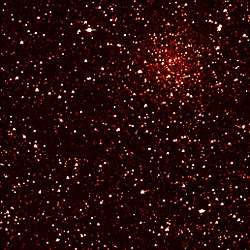NGC 6791
NGC 6791 is an open star cluster in the Lyra constellation.[1] It was discovered by Friedrich August Theodor Winnecke in 1853. At roughly 8 billion years old, and with an Iron to Hydrogen abundance ratio that is more than twice that of the Sun, it is one of the oldest and most metal-rich clusters in the Milky Way. This is contrary to the typical rule-of-thumb where older means more metal-poor. Compounded with the fact that it has an unusually high population of stars, NGC 6791 is among the most studied clusters in the sky.[3][4]
| NGC 6791 | |
|---|---|
 Detail from the Kepler image showing NGC 6791. Celestial north is to the left.a | |
| Observation data (J2000 epoch) | |
| Constellation | Lyra |
| Right ascension | 19h 20m 53s[1] |
| Declination | +37° 46.3′[1] |
| Distance | ~13,300 ly (4078 pc) |
| Apparent magnitude (V) | +9.5[1] |
| Apparent dimensions (V) | 16'[2] |
| Physical characteristics | |
| Notable features | One of the oldest known open clusters |
| Other designations | C 1919+377, Cl Berkeley 46, OCl 142.0,[1] GC 4492[2] |
Age studies
Among the dimmest stars in the cluster are groups of white dwarfs that are 6 billion years old and another group that appear to be 4 billion years old. The ages are out of sync with those of the cluster's normal stars, which are 8 billion years old. This seeming contradiction in age for this cluster has been studied and a solution proposed with age of about 8 billion years.[5][6][7]
The Kepler Mission

In March 2009 NASA launched the Kepler Mission spacecraft. This spacecraft was a dedicated mission to discover extrasolar planets by the transit method from solar orbit. In April 2009 the project released the first light images from the spacecraft and NGC 6791 was one of two objects highlighted.[8]
The planet hosting star Kepler-19, discovered from Kepler data, is located approximately 5 arcminutes Northwest of NGC 6791 . The star has a differing proper motion to the cluster and is also much closer, so it is unrelated.

Notes
- Note a: The images are rotated counterclockwise approximately 130° from the detector orientation against the sky.
References
- "NGC 6791". SIMBAD. Centre de données astronomiques de Strasbourg. Retrieved 2009-05-10.
- NGC online. "NGC 6791". Archived from the original on 2007-08-19. Retrieved 2009-05-10.
- Chaboyer; Green, Elizabeth M.; Liebert, James (March 1999). "The Age, Extinction, and Distance of the Old, Metal-rich Open Cluster NGC 6791" (PDF). The Astronomical Journal. 117 (3): 1360–1374. arXiv:astro-ph/9812097. Bibcode:1999AJ....117.1360C. doi:10.1086/300794.
- Kaluzny; Udalski, A. (1992). "Photometric Study of the Old Open Cluster NGC 6791" (PDF). Acta Astronomica. 42 (1): 29–47. Bibcode:1992AcA....42...29K.
- Bedin; King, Ivan R.; Anderson, Jay; Piotto, Giampaolo; et al. (May 10, 2008). "REACHING THE END OF THE WHITE DWARF COOLING SEQUENCE IN NGC 6791" (PDF). The Astrophysical Journal. 678 (2): 1279–1291. arXiv:0801.1346. Bibcode:2008ApJ...678.1279B. doi:10.1086/529370. Archived from the original (PDF) on March 31, 2017. Retrieved May 10, 2009.
- Bedin; Salaris, M.; Piotto, G.; Cassisi, S.; et al. (May 20, 2008). "THE PUZZLING WHITE DWARF COOLING SEQUENCE IN NGC 6791: A SIMPLE SOLUTION" (PDF). The Astrophysical Journal Letters. 679 (1): L29–L32. arXiv:0804.1792. Bibcode:2008ApJ...679L..29B. doi:10.1086/589151. Archived from the original (PDF) on March 31, 2017. Retrieved May 10, 2009.
- Grundahl; Clausen, J. V.; Hardis, S.; Frandsen, S. (2008). "A new standard: age and distance for the open cluster. NGC6791 from the eclipsing binary member V20". Astronomy & Astrophysics. 492 (1): 171–184. arXiv:0810.2407. Bibcode:2008A&A...492..171G. doi:10.1051/0004-6361:200810749.
- "Kepler Eyes Cluster and Known Planet". NASA. 2009-04-16. Retrieved 2009-05-09.
External links
| Wikimedia Commons has media related to NGC 6791. |
- What's My Age? Mystery Star Cluster has 3 Different Birthdays
- NASA Astronomy Picture of the Day: NGC 6791 (12 January 2000)
- NGC 6791 - LRGB image based on two hours total exposure
- NGC 6791 on WikiSky: DSS2, SDSS, GALEX, IRAS, Hydrogen α, X-Ray, Astrophoto, Sky Map, Articles and images